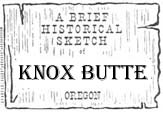|
|
Knox Butte |
|
|
Besides the town above mentioned there were in Linn County certain pioneer “neighborhoods” that might almost be counted communities, One of them was Knox Butte.... George Minshall Knox of Albany, grandson of James Knox after whom Knox Butte is named, describes early day scenes about Knox Butte (131). “I was born on the Jones Knox claim, near the crossroads northwest of the Butte, August 6, 1859. My grandfather, James Knox, born in 1790, came to Oregon in 1845; my grandmother, Lettitia Smith Knox was born in 1785. They were already married and had quite a family when they came to Linn County. None of the children were married except Elizabeth Knox whose husband was Henry Spalding. This couple had a son who died in 1853 and was the first recorded burial in Knox Butte cemetery. “The first election ever hold in Linn County under the provisional government, was held in a barn on the Knox claim. All records are lost, except those concerning election of legislators. However, tradition claims Jason Wheeler was elected sheriff. The site of that election is on what is now known as the Chambers farm. “The Knox family were all Methodists. Services were first held in my grandfather’s cabin and later in various schoolhouses. There was no Methodist Church built until about 1872, when Trinity Chapel was erected on the Geisenderfer farm about four miles east of Albany. “The earliest neighbors about Knox Butte were the Babers, Haights and Chambers, all connected with the Knox family by marriage. East of the Butte were the Earls, and later the Lines family. Near the Santiam the Anderson Cox family had a sawmill and another was built by John Powell, the Christian Church preacher. Ludlow Maxwell also settled near the Santiam, close to where Cottonwoods Inn now stands. “There was a tile factory, though not in the very early days, beside what is now the Central Christian Church cemetery and the deep clay pits may still be seen. The factory was probably running in the late 1870’s or early 1880’s. The Ramsay family lived south of the tile factory near the old Dunkard Church, and a potter’s shop was there at one time. “My grandfather donated the land for the Knox Butte cemetery. There are a number of very old graves on the Lines’ Place on the eastern side of the Butte, but I know of no one who can tell who was buried there. The place is now grown up to large trees. The first school near the Butte was located not far from the Central Christian Church cemetery; after that there was a school southwest of the Butte, where the school now stands; I went to the latter place. One of my first teachers was William Cole, father-in-law of Fred Veal who runs the Albany chair factory, and he taught for quite a while. Biggers and Burkhart were also my teachers.”... Concerning pioneers named in the foregoing: G. H. Baber was born in Bedford County, Virginia, Feb. 14, 1817, and came to Oregon in 1845, to Linn County in 1846. He went to the California goldfields in 1848, returning to Oregon in 1849. In 1851 he was Linn County Judge. He made a second trip to California, come back to live in Washington County. He was married twice - to Elizabeth J. Knox in 1843; who died in 1874. To Minnie Krauss in 1875 (133). She died at Forest Grove, August 1, 1898.
|
Knox Butte Quick Facts Location: Twp 10S, Rge 3W, Sect 35, approx. Name Origin: James Knox, early settler Post Office Established: None. |
||
Town histories were
abstracted from: "History of Linn
County", Compiled by Workers of the Writer’s Program, Works Progress
Administration, 1941. See bibliography
for above-cited references. All photos from the collection of Lisa L.
Jones, unless otherwise noted. Lisa
L. Jones contributed and is solely responsible for the content of these
pages. Copyright 2001.
